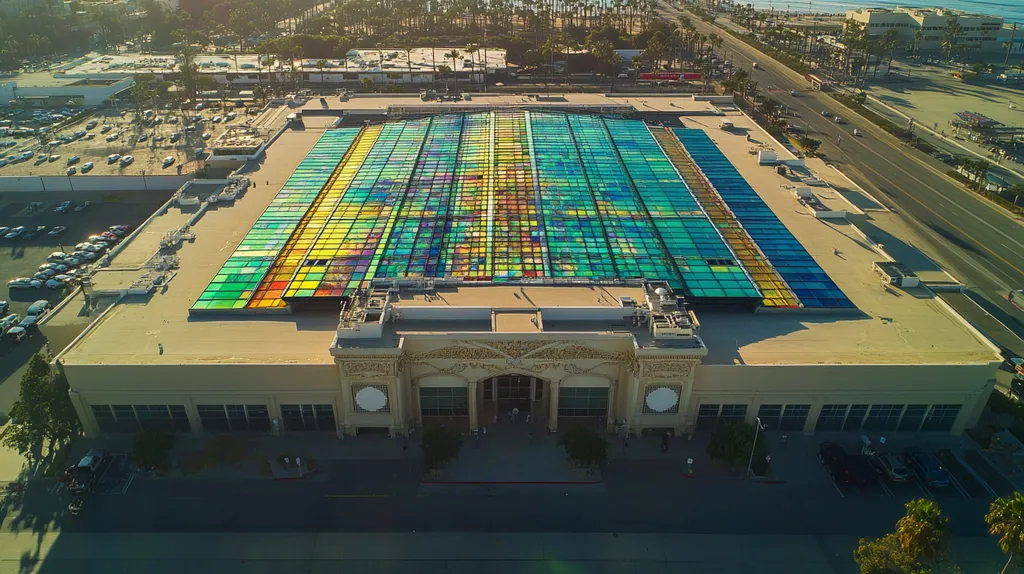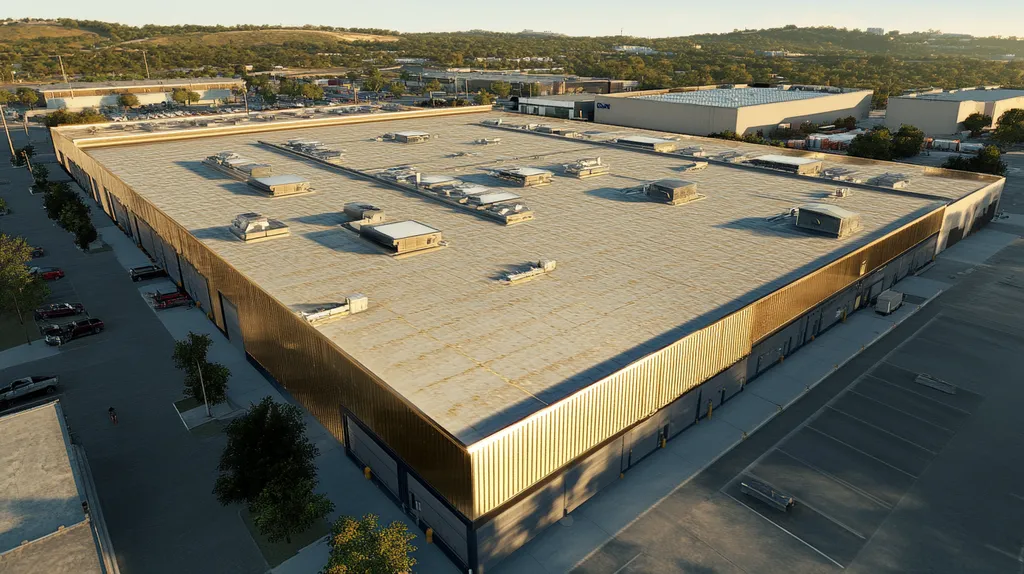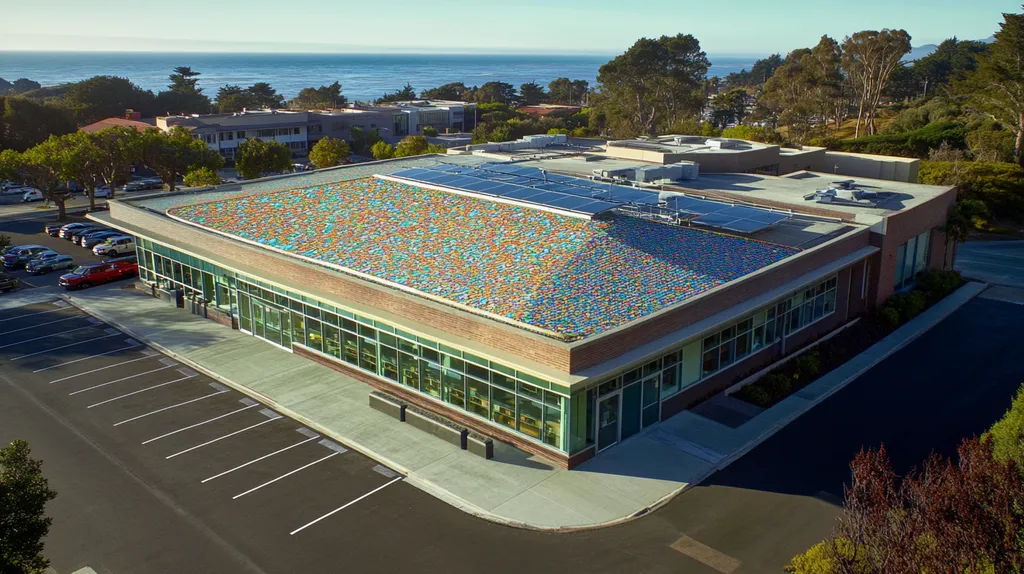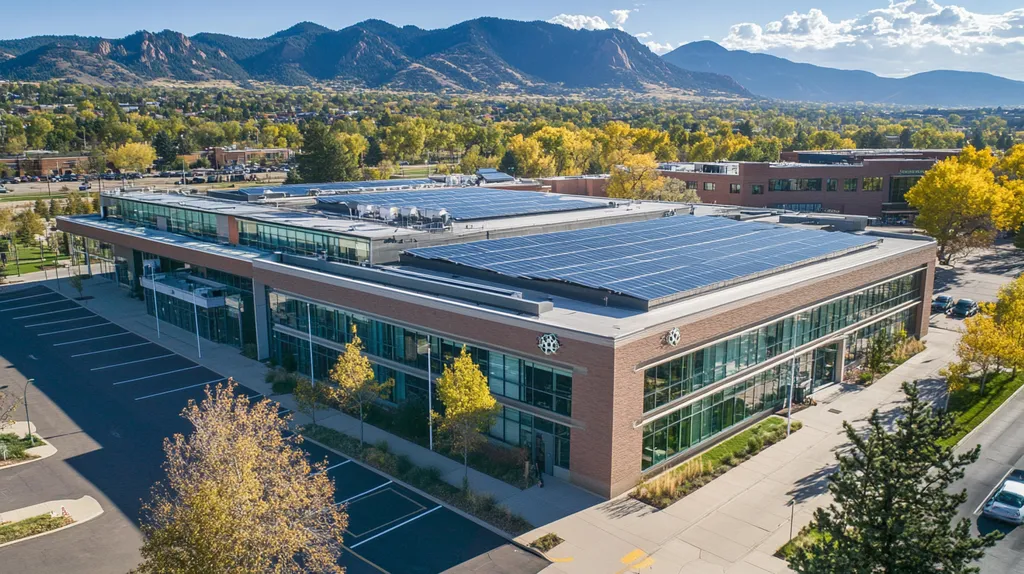Water accumulation on commercial roofs poses a critical threat, with studies showing that 70% of premature roof failures stem from inadequate ponding water protection. For facility managers and property owners, this translates to millions in annual repair costs and preventable structural damage.
Modern roof coating technologies offer powerful solutions for combating ponding water, yet selecting and implementing the right system requires careful consideration of multiple factors.
This comprehensive guide examines the science behind ponding water resistance, exploring coating types, application methods, maintenance protocols, and performance metrics that ensure long-term roofing success.
SECTION 1: FUNDAMENTAL CONCEPTS
Ponding water on commercial roofs is not just an inconvenience; it represents a serious threat to the integrity and longevity of roofing systems. Research shows that about 70% of roofing failures can be traced back to water accumulation. For property owners, grasping the nature of ponding water, its causes, and its consequences plays a crucial role in effective roof management and decision-making regarding coatings. This section explores the vital concepts associated with ponding water and its implications for commercial roofing.
Definition of Ponding Water
Ponding water is the pooling of water on a roof surface due to inadequate drainage. Specifically, it is defined as water that remains on the roof for more than 48 hours post-rainfall. This condition can create numerous complications, including excessive weight on the structure and deterioration of roofing materials.
When water accumulates, it can hinder the performance of roof coatings, obstructing water flow into drainage systems and leading to increased damage. For property owners, understanding ponding water is essential for implementing appropriate maintenance and preventive strategies.
Properties situated in regions with heavy rainfall or poor drainage are particularly vulnerable to this issue. Therefore, identifying and resolving ponding water quickly is crucial for sustaining the health of a commercial roofing system.
In essence, ponding water cannot be dismissed as merely a nuisance; it is a genuine risk warranting continuous vigilance and proactive management.
Causes of Ponding Water on Roofs
Ponding water typically results from several factors that disrupt a roof’s drainage system. Design flaws, such as insufficient slope or a lack of adequate drainage outlets, often lead to water buildup. New construction projects might neglect these fundamental design aspects, elevating the risk of ponding.
Debris accumulation is another frequent contributor. Leaves, branches, and dirt can obstruct drainage systems, impeding the natural flow of water off the roof. Neglecting regular maintenance can worsen this problem, creating extensive areas of ponding during storms.
Changes to the building’s footprint, such as the installation of HVAC units or other rooftop equipment, can also alter drainage patterns, leading to stagnant water areas. Recognizing these causes is essential for property owners looking to reduce the hazards associated with ponding water.
Lastly, natural settling of the building can create low spots on the roof where water tends to collect. This emphasizes the necessity for regular inspections to identify and correct potential issues before they lead to larger problems.
Impact of Ponding Water on Roofing Materials
The consequences of ponding water on roofing materials can be detrimental. Extended exposure to standing water can significantly accelerate the breakdown of roofing membranes, resulting in leaks and other structural damage. For instance, single-ply membranes may lose their waterproof capabilities, leading to costly repairs.
Ponding water also fosters mold and mildew growth, which can pose health risks to building occupants. Commercial facilities grappling with moisture issues may face not only structural challenges but also air quality concerns that affect tenant satisfaction and diminish rental values.
Moreover, the added weight from ponding water places additional strain on a building’s structural components. This unsettling load might necessitate costly reinforcements or, in extreme cases, lead to structural failures if left unaddressed.
Ultimately, roofing materials may require more frequent replacements due to the accelerated deterioration caused by ponding water. This highlights the importance of choosing the right roof coatings that effectively manage water accumulation. Understanding these impacts is vital for property owners aiming to maintain a robust and reliable roofing system.
SECTION 2: SYSTEM COMPONENTS
Addressing ponding water on commercial roofs is essential for extending roof lifespan and ensuring structural integrity. Statistics indicate that over 60% of flat roofs experience water accumulation at some point, underscoring the need for suitable roof coatings. Selecting the right type of coating can significantly reduce risks such as leaks and structural damage. This section examines various roof coating options and their key characteristics in combating the challenges posed by ponding water.
Types of Roof Coatings for Ponding Water
There are several effective types of roof coatings specifically designed to tackle ponding water issues. These include silicone, acrylic, and polyurea coatings, each offering distinct benefits in terms of flexibility, durability, and ease of application.
Silicone coatings stand out for their exceptional waterproof properties and resistance to UV rays. They create a seamless membrane that effectively blocks water infiltration. However, proper surface preparation is essential to ensure a strong bond.
Acrylic coatings, being water-based and more environmentally friendly, provide excellent reflectivity and are generally easier to apply. Although they may not completely eliminate standing water, their ability to expel moisture helps minimize ponding risks.
Polyurea coatings are recognized for their rapid curing, high tensile strength, and resilience under severe weather conditions. They are an ideal option for roofs that face significant ponding challenges, providing long-lasting protection.
Key Characteristics of Silicone and Acrylic Coatings
Understanding the distinct properties of silicone and acrylic coatings is crucial for making informed decisions. Silicone coatings offer remarkable resistance to both water and algae growth, helping to prolong their lifespan and reduce maintenance costs.
Acrylic coatings excel in flexibility, enabling them to adapt to thermal expansion and contraction without cracking. They are also highly reflective, enhancing energy efficiency in commercial buildings by lowering cooling costs.
Installation requirements also differ. Silicone coatings often necessitate specialized training for application, which may restrict the pool of qualified contractors. Conversely, acrylics can generally be installed by a wider range of professionals, offering operational flexibility.
While both coating types effectively address the challenges posed by ponding water, they serve different roofing systems and environmental contexts, ensuring that property owners have tailored solutions available.
Compatibility with Various Roofing Materials
The compatibility of roof coatings with existing roofing materials is a critical consideration when addressing ponding water. Not all coatings bond effectively to every roofing substrate, and understanding these interactions can lead to optimal performance.
For example, silicone coatings work exceptionally well on EPDM rubber and TPO roofing systems due to their strong adhesive properties and long-lasting waterproofing capabilities. In contrast, acrylic coatings typically form excellent bonds with metal and spray foam roofing.
Compatibility is also influenced by the current state of the roof’s surface. Roofs layered with significant moss or debris may require thorough cleaning and priming before applying any coatings. Property managers should ensure surfaces are adequately prepared to avoid the costly consequences of premature failures.
Ultimately, choosing the right coating goes beyond understanding material properties; it also involves assessing the existing roof conditions to secure a repair solution that delivers both immediate and long-term value.
SECTION 3: IMPLEMENTATION METHODS
Ensuring commercial roof coatings resist ponding water involves precise and diligent implementation methods. Neglecting these steps can lead to costly repairs or even premature roof failures. Research indicates that roofs suffering from chronic ponding may lose up to 25% of their lifespan. This section examines essential strategies, from preparation to application techniques, to achieve the best results for your roofing investment.
Preparation of Roof Surfaces for Coating
The success of any roof coating hinges on proper surface preparation. It begins with a thorough inspection to uncover existing damage, debris, and contaminants. Roofs must be meticulously cleaned, using power washing or specialized cleaning solutions to eliminate dirt, algae, and other harmful elements.
It’s also crucial to address any cracks or holes by patching them to ensure a uniform surface. This step minimizes the risk of water infiltration and enhances the bonding of the coating. Importantly, areas prone to ponding should be evaluated for drainage improvements to boost overall performance.
Following the cleaning and repairs, allowing the surface to dry completely is vital. A wet surface can hinder adhesion and reduce the lifespan of the coating. Such meticulous preparation lays a solid groundwork for a successful application.
Application Procedures for Silicone and Acrylic Coatings
Applying silicone and acrylic coatings involves specific procedures that must be followed to ensure effectiveness. For silicone coatings, it’s vital to apply them onto a clean and dry surface. Depending on manufacturer guidelines, these can often be applied in one or two coats.
Acrylic coatings, on the other hand, require a more meticulous approach. Multiple thin coats are typically necessary to ensure proper coverage and thickness. Applicators should use rollers or spray equipment for even distribution while avoiding pooling that could lead to ineffective results.
Quality control throughout the application process is essential. Engaging skilled labor helps ensure coatings are applied uniformly, especially in areas vulnerable to ponding. Adhering to manufacturer instructions regarding temperature and humidity is also crucial for optimal curing.
Ensuring Proper Adhesion and Curing
Additionally, ongoing maintenance is important to ensure coatings retain their effectiveness against ponding. Regular inspections and reapplication may be necessary to address wear and tear, significantly extending the life of the roof.
SECTION 4: MAINTENANCE REQUIREMENTS
Maintaining commercial roofing systems is not merely a routine task; it is essential for preventing costly damage caused by ponding water. Neglecting this maintenance can lead to a staggering reduction in roof lifespan by up to 50%. Regular upkeep allows property owners and facility managers to spot potential issues early, ensuring that protective coatings function effectively and contribute to the roof’s longevity.
Regular Inspection for Ponding Water Issues
Regular inspections are critical for identifying ponding water issues before they escalate. Property managers should conduct roof evaluations at least twice a year, ideally just before and after the rainy season, to align with potential weather patterns.
During these inspections, it’s vital to look for visible water accumulation, particularly in low-sloped areas. Engaging a qualified roofing contractor can guarantee a comprehensive analysis of both the roof coating and the drainage systems in place.
Keeping a detailed maintenance log of inspection findings and performed maintenance can help track trends over time. This proactive approach not only extends the roofing system’s life but also safeguards the building’s structural integrity and the valuable assets inside.
Repairing Leaks and Damaged Coating Areas
Promptly addressing leaks and any damage is essential to maintaining overall roof performance. Signs of wear, especially in critical areas like seams and flashing, should be repaired without delay to prevent further deterioration.
High-quality roofing sealants and patches should be utilized to ensure compatibility with existing coatings. The right materials can significantly enhance the coating’s durability and resistance to ponding water.
Ongoing monitoring after repairs is essential to confirm their effectiveness. Follow-up inspections may be necessary to ensure that repaired areas are performing as required, minimizing the risk of further complications.
By investing in timely repairs, property owners can avoid more extensive and costly damage, thereby ensuring that all areas of the roof remain watertight for sustained performance.
Recoating and Renewal Strategies
Recoating is a strategic measure that not only revitalizes a roof but also boosts its resistance to ponding water. Property owners should regularly evaluate the need for recoating based on the condition and performance of the existing coating.
When considering recoating, it’s beneficial to choose products specifically designed for commercial roofs. Selecting the right materials based on factors such as climate exposure can enhance both durability and adhesion.
Timing plays a pivotal role in recoating; applying a fresh layer before significant weather events can fortify the roof’s defenses against water accumulation. Establishing a regular recoating schedule, typically every 5 to 10 years, helps maintain the roof’s aesthetics and functionality.
Not only is this practice efficient, but it also frequently results in significant savings over the roof’s lifespan, reinforcing the long-term viability of the investment.
SECTION 5: PERFORMANCE METRICS
The effectiveness of commercial roof coatings in resisting ponding water hinges on quantifiable performance metrics. In an industry where water accumulation can lead to severe damage, recognizing these metrics is paramount. Nearly 40% of roofing failures stem from poor water management. This section delves into critical performance tests for roof coatings, highlighting tensile strength, weathering capabilities, and moisture interaction—each vital to ensuring the longevity of roofing systems.
Tensile Strength and Elongation Testing
Tensile strength and elongation testing are essential for evaluating a roof coating’s durability. These tests measure how much a material can stretch and bear weight without succumbing to failure. A coating with high tensile strength is crucial in areas subject to heavy foot traffic or equipment placement.
Equally important is elongation, particularly for coatings facing ponding water. A coating that can stretch without cracking adapts better to temperature shifts and the resulting expansion and contraction. This flexibility is critical for roofs regularly battling stagnant water.
Industry standards stipulate minimum values for both tensile strength and elongation. Coatings meeting or exceeding these benchmarks are more likely to withstand harsh environmental conditions, enhancing the roof’s lifespan.
Property owners should request test results for potential coatings to ensure they meet these vital criteria. This diligence can prevent future issues and safeguard investment over time.
Weathering and UV Resistance Evaluation
Weathering and UV resistance are key metrics for assessing how roof coatings will perform throughout their lifespan. Ultraviolet rays from the sun can degrade coatings, leading to premature failures. Without adequate UV protection, a coating may deteriorate, compromising the roof’s overall integrity.
Weathering tests expose materials to simulated weather conditions that replicate years of exposure to sun, rain, and wind. The results help predict how a coating will perform in real-world elements and maintain its protective properties.
Coatings with high UV resistance tend to retain their color and flexibility, crucial for safeguarding the roof substrate. Property owners should prioritize coatings that demonstrate strong weathering and UV performance metrics, ensuring lasting protection against environmental challenges.
This preventative strategy not only extends a roof’s life but can also enhance energy savings through improved insulation. A robust roof positively impacts overall energy efficiency, benefiting commercial facilities long-term.
Water Vapor Permeability and Moisture Absorption
Water vapor permeability and moisture absorption are crucial in evaluating a roof coating’s effectiveness in managing ponding water. Coatings that allow moisture to escape while preventing water ingress are optimal for preserving the roof’s structural integrity.
A coating with low vapor permeability can trap moisture within the roofing assembly, leading to issues like mold growth and structural decay over time. Conversely, coatings with suitable permeability levels promote moisture escape, minimizing damage risks.
Additionally, moisture absorption rates indicate how much water a coating can absorb when exposed to standing water. Coatings designed for wet environments typically exhibit low absorption rates, enhancing their durability in ponding conditions.
Selecting a coating that excels in both vapor permeability and low moisture absorption mitigates risks associated with structural deterioration, particularly important for commercial roofs where significant investment is in play and maximizing longevity is vital.
SECTION 5: PERFORMANCE METRICS
The effectiveness of commercial roof coatings in resisting ponding water is underscored by measurable performance metrics. In a landscape where water buildup can lead to substantial damage, understanding these metrics becomes crucial. Alarmingly, nearly 40% of roofing failures stem from inadequate water management. This section focuses on essential tests that reveal how roof coatings perform in challenging conditions, zeroing in on tensile strength, weathering capabilities, and moisture interaction.
Tensile Strength and Elongation Testing
Tensile strength and elongation testing are vital for gauging a roof coating’s durability. These tests assess how much a material can stretch and withstand weight without failing. A coating with robust tensile strength is crucial in high-traffic areas or where heavy equipment sits, as it resists tearing effectively.
Equally important is the elongation property, especially for coatings exposed to ponding water. A flexible coating can stretch without cracking and is better equipped to deal with the constant expansion and contraction caused by temperature changes. This adaptability is essential for roofs prone to standing water.
Industry standards typically set minimum expectations for both tensile strength and elongation. Coatings that meet or exceed these benchmarks are more likely to endure severe weather conditions, contributing to a longer-lasting roofing system.
Property owners should actively seek out test results for any potential coatings, ensuring they fulfill these essential criteria. This proactive approach can help prevent future problems and safeguard the investment in roofing systems.
Weathering and UV Resistance Evaluation
Assessing weathering and UV resistance is critical for determining a roof coating’s performance over time. The harsh ultraviolet rays can deteriorate coatings, leading to premature failures. Without adequate UV protection, coatings may degrade, jeopardizing the roof’s structural integrity.
Weathering tests simulate long-term exposure to sun, rain, and wind, enabling property owners to predict how a coating will perform under real-world conditions. These evaluations reveal whether coatings can maintain their protective qualities despite environmental challenges.
Coatings boasting high UV resistance maintain their color and flexibility, essential for protecting the underlying roof substrate. Property owners should prioritize these coatings to ensure enduring protection against the elements.
This proactive mindset not only enhances the roof’s longevity but can also lead to energy savings through better insulation. An efficient roof significantly benefits the overall energy performance of commercial buildings.
Water Vapor Permeability and Moisture Absorption
Water vapor permeability and moisture absorption are key metrics for evaluating a roof coating’s effectiveness in managing ponding water. Ideal coatings allow moisture to escape while preventing water ingress, ensuring the roof’s structural integrity is preserved.
Coatings with low vapor permeability may trap moisture within the roof assembly, increasing the risk of mold growth and structural decay over time. In contrast, coatings with appropriate permeability levels enable trapped moisture to escape, considerably reducing potential damage.
Moreover, assessing moisture absorption rates helps gauge how much water a coating can take on when exposed to standing water. High-performing coatings designed for challenging wet environments typically exhibit low absorption rates, enhancing longevity in ponding conditions.
Selecting a coating that excels in water vapor permeability and moisture absorption minimizes risks associated with structural deterioration. This consideration is particularly critical for commercial roofs, where significant financial investments and maximizing longevity are paramount.
The Bottom Line
With water damage accounting for over $13 billion in commercial property losses annually, the importance of proper roof coating selection and implementation cannot be overstated.
Modern coating technologies, when correctly specified and installed, can extend roof life by 15-20 years while delivering substantial energy savings through improved thermal performance.
Success depends on understanding the interplay between coating types, application methods, and ongoing maintenance requirements.
As climate patterns continue to intensify, implementing robust ponding water solutions becomes increasingly critical for protecting commercial real estate investments.
Property owners who embrace comprehensive coating strategies, supported by regular inspections and timely maintenance, position themselves to maximize both building performance and long-term value.
FREQUENTLY ASKED QUESTIONS
Q. What is ponding water on commercial roofs?
A. Ponding water refers to the accumulation of water on a roof surface for more than 48 hours. It poses serious risks to the integrity of roofing systems, leading to potential leaks, structural damage, and decreased roof lifespan. Understanding this condition aids in effective maintenance and decision-making regarding roof coatings.
Q. Which coatings are best for an industrial roof with ponding water?
A. Optimal options include silicone, acrylic, and polyurea coatings. Silicone is recognized for its waterproofing and UV resistance, while acrylic is environmentally friendly and highly reflective. Polyurea coatings cure quickly and offer durability under challenging weather conditions, making them suitable for roofs facing significant water accumulation.
Q. How do I prepare my commercial roof for coating?
A. Preparation involves thoroughly inspecting the roof to identify damage and cleaning the surface. Using power washing or specialized solutions removes dirt and algae. Any cracks or holes should be patched to improve uniformity, and ensuring a dry surface before application is crucial for effective coating adhesion.
Q. How often should I inspect my commercial roof for ponding water?
A. It’s advisable to conduct roof inspections at least twice a year, ideally before and after the rainy season. These evaluations help identify any visible water accumulation, especially in low-slope areas. Being proactive can prevent more extensive damage and extend the lifespan of your roofing system.
Q. What performance metrics should I consider for commercial roof coatings?
A. Key metrics include tensile strength, elongation, weathering resistance, and water vapor permeability. Tensile strength indicates how much weight a coating can bear without failing, while elongation assesses flexibility. Evaluating weathering resistance ensures long-term durability, and moisture absorption rates are crucial for preventing structural decay.
Q. When should I consider recoating my commercial roof?
A. Recoating should be considered based on the condition of your existing coating, typically every 5 to 10 years. Factors like climate exposure and visible wear can influence the timing. Applying a new layer before extreme weather can enhance your roof’s defenses, ultimately preserving its performance and appearance.
Q. Can inadequate roof coatings lead to further issues?
A. Yes, using inadequate coatings can result in premature roofing failures and costly repairs. They may not adequately protect against water infiltration and wear, leading to leaks and structural damage. Ensuring the right coating for your commercial roof is essential for long-term maintenance and safeguarding your investment.











